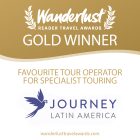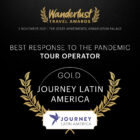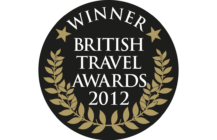Private Journeys
Self-drive Ecuador: The Avenue of the Volcanoes
11 days from £2,850pp
(based on two people sharing & excluding flights)
Itinerary
 Map
Map
Day 1
Arrive Quito, transfer to hotel in historic centre.
You’ll be escorted to your hotel in Quito, the Andean capital of Ecuador. The active volcano Guagua Pichincha, to the east, glowers over the dynamic city which, at 2,850m, is one of highest capitals in the world. Quito is divided into two contrasting districts. The modern zone is characterised by towering glass buildings and houses banks, international companies, hotels, shops and restaurants, while the central colonial area has well-conserved and recently spruced-up white-washed architecture, open air markets and graceful Spanish-style mansions and churches.

Stay at -
Casona de la Ronda
Day 2
Guided walking tour of the colonial core.
Visit the colonial centre of the capital, the first city ever to be listed as a UNESCO World Heritage Site. High on the agenda is a walk through the main plaza, the Plaza de Independencia, where you will see the government palace, the cathedral, and some of the most important churches built around the 16th and 17th centuries, including the monastery of San Francisco. It’s beguilingly beautiful but the authorities have been concerned not to prettify the core too much and drive out the local population, so many of the refurbishments are subtle; pedestrianisation proceeds apace but small family run shops, bars and restaurants abound.

Stay at -
Casona de la Ronda
Day 3
Transfer to the airport to collect your hire car; set off on your self-drive adventure.
With our assistance you will be accompanied to the rental agency to collect your car. Today you’ll be driving south towards Cotopaxi National Park, which has as its dominant feature the towering snow-mantled cone of the towering volcano Cotopaxi.
You won’t be taking the principal artery, the Panamerican Highway, at this stage (unless you chose to), instead head off down the original road south from Quito, an undulating cobbled road enjoying only light rural traffic and more likely accommodating cattle and cowboys . The peaceful undulating route leads you past dairy farms, isolated hamlets and dark pine forests while the near vertical bulk of massive volcanoes rear ahead. You’re gradually climbing, though you won’t really notice it, but the landscape opens out into rough open grasslands rimmed by rugged treeless hills.
The road is a little bumpier as you approach Chilcabamba, where you’ll be spending the night at a delightful and welcoming lodge on the edge of the national park. You may pause just before reaching the lodge for a short self-guided walk to view the pretty waterfall on the rocky bed of the river Pita, which supplies much of Quito’s water. The lodge offers you your first views of the jaw-droppingly majestic Cotopaxi volcano, piercing the sky at 5,897m with its icy cape. There are short self-guided walks in the grounds where you can stretch your legs and learn a bit about the high-altitude flora.

Stay at -
Chilcabamba Mountain Lodge
Day 4
Cotopaxi National Park, drive to Quilotoa.
After a peaceful night warmed by your wood-burner in the cosy lodge you’ll enter the park through its more remote northern gateway. Cotopaxi’s (very) occasionally active peak towers above its rumpled skirts of highland moor, blanketed with a tundra-like vegetation of altitude-resistant shrubs and flowers.
The park is inhabited by over 90 species of bird from pocket-sized hummingbirds to giant condors and a variety of hardy mammals including deer, rabbits, Andean foxes and puma, which shelter from view in the lacy veils of frequent swirly mists. You have the opportunity to walk the trail surrounding the stunningly reflective Lake Limpiopungo, ringed by bird-filled reed beds. Alternatively, drive up the steep rocky road on the volcano’s flanks to the snow line at 4,800m for mesmerising views over the wilderness of the park below (caution is required here – the air is very rarefied at this altitude).
You may choose to have lunch at Tambopaxi Lodge before driving west to Quilotoa, an extinct volcano whose crater harbours a shimmering blue-green lagoon. En route you may call in at one of the many regional indigenous markets: Saquisili, Pujili or Zumbahua; choose your village according to your day of travel. The normally sleepy towns are transformed with stalls piled high with fruit, household and artisan goods – it’s not just for tourists – truly an authentic experience. Another stop can be made at the artists’ town Tigua, where the landscapes are particularly exquisite. Patchwork quilts of amber and emerald fields worked by farmers wearing bright red ponchos are dotted with thatched adobe cottages.
Approaching Quilotoa you’ll take a purple lupin-fringed road up to a viewpoint over the lake at Shalala. Continue to spend another cosy night at a welcoming, family-run countryside lodge in the hamlet of Chugchillan.

Stay at -
Hostal Mama Hilda
Day 5
Drive to thermal spa resort town, Baños.
Take a sinuous road back to the Avenue of the Volcanoes and travel south to Ambato where you leave the main highway again and take a road which eventually heads steeply down to the Amazon basin. You don’t go this far though – stop at the spa resort town Baños, clinging to the edge of a cliff face and rimmed by racing green hills. Glowering over the town is the volcano Tungurahua, still active with a few hissing fumeroles but not expected to erupt in the near future. Your lodge and spa, built in the style of a colonial hacienda, has a countryside location where you can drink in the views of exquisite Andean scenery.
You’ll stop here for two nights, with a full day to explore the area – you may choose to leave the car behind, or head off back on the road to discover new delights.

Stay at -
Samari Spa Resort
Day 6
At leisure in Baños – optional adventures.
You may be tempted just to relax in the hotel gardens or spa, but there’s lots to do outside. Visit the thermal baths, or If you want to stretch your legs, head off on one of the self- guided trails which criss-cross the valley slopes just outside town, or you can sign up for one of the many active adventures on offer: horse riding, mountain biking, white water rafting, kayaking.
Alternatively carry on down the road which leads to Amazonia: it’s a dramatic drive through a narrow gorge, a corridor punctuated with tunnels drilling through the ever-rising crests of vertiginous mountain ranges. In fact, it’s known as the Route of the Waterfalls: it’s only a 30-45 minute drive to peer down on the Pailon del Diablo (Devil’s Cauldron), one of the most impressive of these.
An even more ambitious day trip takes you west along the road to Chimborazo National Park. The volcano Chimborazo, perhaps Ecuador’s second most famous peak, is as an impressive sight on a clear day as Cotopaxi. If you don’t make it to the park for mind-boggling close up views, you should be able to catch sight of the peak on the following day as you drive on to Riobamba and Alausi.

Stay at -
Samari Spa Resort
Day 7
Drive to Alausi.
There are two options for this southwards drive, both taking about three hours in the unlikely event you drive without stops. The first option has you joining the Panamerican Highway, the busier of the two routes but the one which takes you closer to the imposing volcano Chimborazo and also invites you to stop at Colta, where you will find the very first Catholic church in Ecuador and a pretty lagoon.
Alternatively you can take a smaller but very scenic road which clings to the slopes of a steep valley to the east of the Panamerican. Here there is very little traffic and you are unlikely see any other visitors, just a few campesinos possibly knitting as they wait patiently for a lift to one of the small towns along the route.
The routes merge in an open fertile landscape at Guamote (Thursday market), an authentic indigenous village with cobblestone streets, set within a jumble of tiny fields worked by villagers warmed by wool ponchos and traditional headgear. The road is just single-lane now, a slower pace of life is once again in the ascendant. You’ve started descending towards the coast. Arrive at your hotel in the dozy, picturesque little town Alausi, characterised by old-style painted adobe houses with wooden balconies.
Please note: The train service from Alausi along the famous Devil’s Nose switchbacks is suspended indefinitely, but it may be possible to visit the site.

Stay at -
Hosteria la Quinta
Day 8
Continue to Cuenca via Ingapirca ruins.
Set off on a long drive south to the city of Cuenca with the option of stopping off at the Inca ruins of Ingapirca (3,160m), the only significant Inca site in Ecuador.
The road winds a bit more now, and there are some large houses indicating a certain prosperity – although remittances from emigrants are responsible for most of this. You can park at Ingapirca and may be able to hire a guide locally to show you around (if you want to be sure of a qualified and experienced English-speaking guide we can provide one at extra cost). Here you can see examples of the extraordinary masonry skills of the Incas, with tightly fitting stones and trapezoidal doors reminiscent of the architecture at Cusco.
Continue to Cuenca, a large city nowadays but which retains a lot of its reputation as an oasis of intellectual thought and for its superior Spanish colonial architecture. You spend two nights at your hotel in town.

Stay at -
Hotel Victoria – Cuenca
Day 9
Relaxed walking tour.
After such an eventful day yesterday you may wish to spend the day exploring the old city, so we introduce you to its long history (there was a Cañari indian settlement here in 500AD, while the Spanish Conquistadores founded their city in 1557) with a guided walking tour of the historic centre. Declared a World heritage site by UNESCO, Cuenca, with its flowery plazas, beautifully renovated churches, cobblestone lanes and museums is a delight to discover. It has earned the nickname “Athens of Ecuador” for its artistic heritage: writers, artists, poets and philosophers have all settled here, and nowadays the congenial ambiance has encouraged the establishment of a thriving expat community.

Stay at -
Hotel Victoria – Cuenca
Day 10
Drive to Guayaquil via las Cajas National Park.
Although you are now heading west down towards the tropical Pacific coast you aren’t quite finished with the high altitude Andean plains yet: from Cuenca you climb for just 30 minutes to reach las Cajas National Park, a vast wilderness of high páramo and boxed lakes. Its tundra, jagged peaks and many glacial lakes have a rugged, eerie beauty. There are various viewpoints – you can park up for a short walk here if you like to admire the wind-buffeted grasslands yawning in front of you.
Having left the park you descend rapidly, dropping 600m in 10 minutes. The landscape is kinder, more fertile, more populated: drive through farmland dotted with horses and cattle, while the vegetation becomes more dense, with cloud forest palm trees and ferns, themselves gradually giving way to banana, cacao and sugar plantations as you approach sea level. Overall, you drop 4,000m in just two hours of driving- there aren’t many places in the world where you can do that.
Arrive in the port of Guayaquil, where eventually you will leave your car at the Agency at the airport. But you have one night here, enabling you to enjoy this incredible city.
Note: You may prefer to return to Cuenca and fly north to Quito before flying home the next day.

Stay at -
Unipark
Day 11
Explore Guayaquil, depart for international flight, the Galápagos islands or the Amazon jungle.
Once famed only for being chaotic and a bit shabby this steamy, tropical city has recently benefitted from a programme of restoration accompanying its increased prosperity, and is now a fascinating place to visit and compare with the oh-so-different Quito and Cuenca in the chilly highlands. The people here are outgoing and flamboyant, in sharp contrast to the more reserved inhabitants of the Andes.
Ramshackle houses crammed onto steep hillsides have been repainted in vibrant colours, while striking contemporary tower blocks glitter along the coastline. There are a number of pleasant parks in which to relax while one of the city’s biggest attractions is the refurbished 2 km malecón (promenade) stretching along the banks of the fast flowing Río Guayas, especially popular among local couples and families in the cool of the early evening.
You’ll have seen so much of the different regions of this varied country, to make your visit complete, consider adding a cruise or land based visit to the Galápagos islands, or a stay in one of a number of jungle lodges in Ecuador’s surprisingly accessible Amazon region.

Outline itinerary
Day 1
Arrive Quito, transfer to hotel in historic centre.
Day 2
Guided walking tour of the colonial core.
Day 3
Transfer to the airport to collect your hire car; set off on your self-drive adventure.
Day 4
Cotopaxi National Park, drive to Quilotoa.
Day 5
Drive to thermal spa resort town, Baños.
Day 6
At leisure in Baños – optional adventures.
Day 7
Drive to Alausi.
Day 8
Continue to Cuenca via Ingapirca ruins.
Day 9
Relaxed walking tour.
Day 10
Drive to Guayaquil via las Cajas National Park.
Day 11
Explore Guayaquil, depart for international flight, the Galápagos islands or the Amazon jungle.
Inspired by this trip
Our exciting range of articles on Latin America explore everything from iconic destinations and lesser-known cultural gems to delicious traditional recipes. You’ll also find exclusive travel tips, first-hand client reviews and the chance to get your personal questions answered by our travel experts.
Papagaio
Your edit for Latin American inspiration
Our exciting range of articles on Latin America explore everything from iconic destinations and lesser-known cultural gems to delicious traditional recipes. You’ll also find exclusive travel tips, first-hand client reviews and the chance to get your personal questions answered by our travel experts.
View Extraordinary Inspiration


































